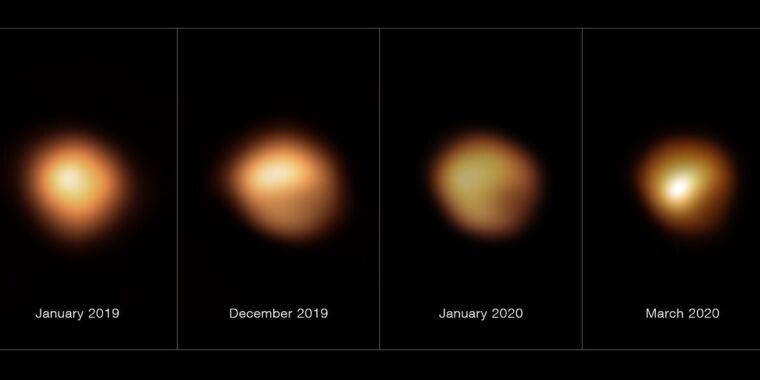
Several months later, they had narrowed the most likely explanations to two: a short-lived cold patch on the star's southern surface (akin to a sun spot), or a clump of dust making the star seem dimmer to observers on Earth.
The star has something akin to a heartbeat, albeit an extremely slow and irregular one.
Over time, the star cycles through periods when its surface expands and then contracts.
While they're easy to track with ground-based telescopes, these shifts don't cause the sort of radical changes in the star's light that would account for the changes seen during the dimming event.
Telescopes pointed at the giant were able to determine that—rather than a tidy, uniform drop in luminance—Betelgeuse's dimming was unevenly distributed, giving the star an odd, squished shape when viewed from Earth.Combined with some timely ground observations, this UV data indicated that a big burp that formed a cloud of dust near the star may have caused the star to get darker.
"With Hubble, we could see the material as it left the star's surface and moved out through the atmosphere, before the dust formed that caused the star to appear to dim," said Andrea Dupree, an astronomer at the Harvard-Smithsonian Center for Astrophysics who made those observations.The findings last year showed that an outer layer of the star, called the photosphere, had begun unevenly accelerating outward right before Betelgeuse began to dim.At its peak, the photosphere was moving at around 7 kilometers per second, reversing the outward push as the dimming of the star became more dramatic.
Dupree and her colleagues suggested that as the star expanded in one of its usual cycles, a portion of the surface accelerated much more rapidly, thanks to a convection cell that had traveled from the interior of the star to its surface.When a convection-driven cold patch appeared on the surface, the local temperature decrease was sufficient to condense the heavier elements (like silicon) into solid dust, forming a dusty veil that obscured the star's brightness in its southern hemisphere.